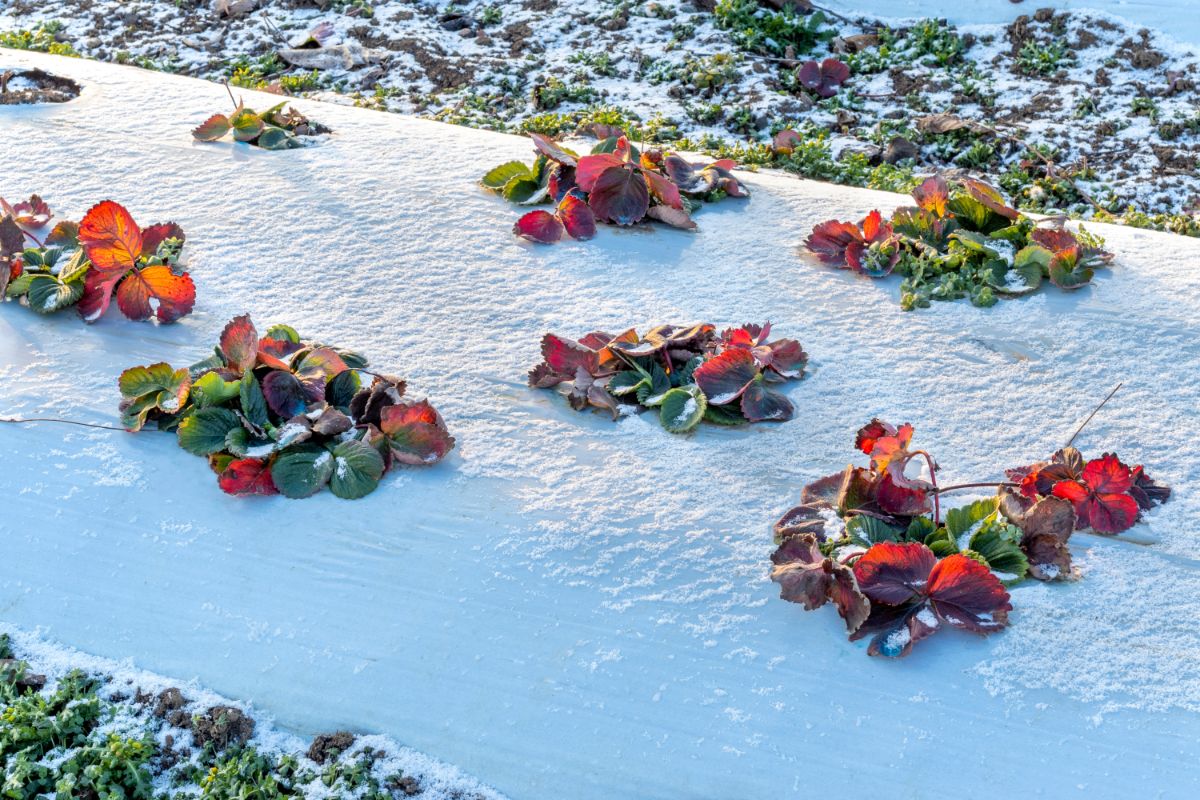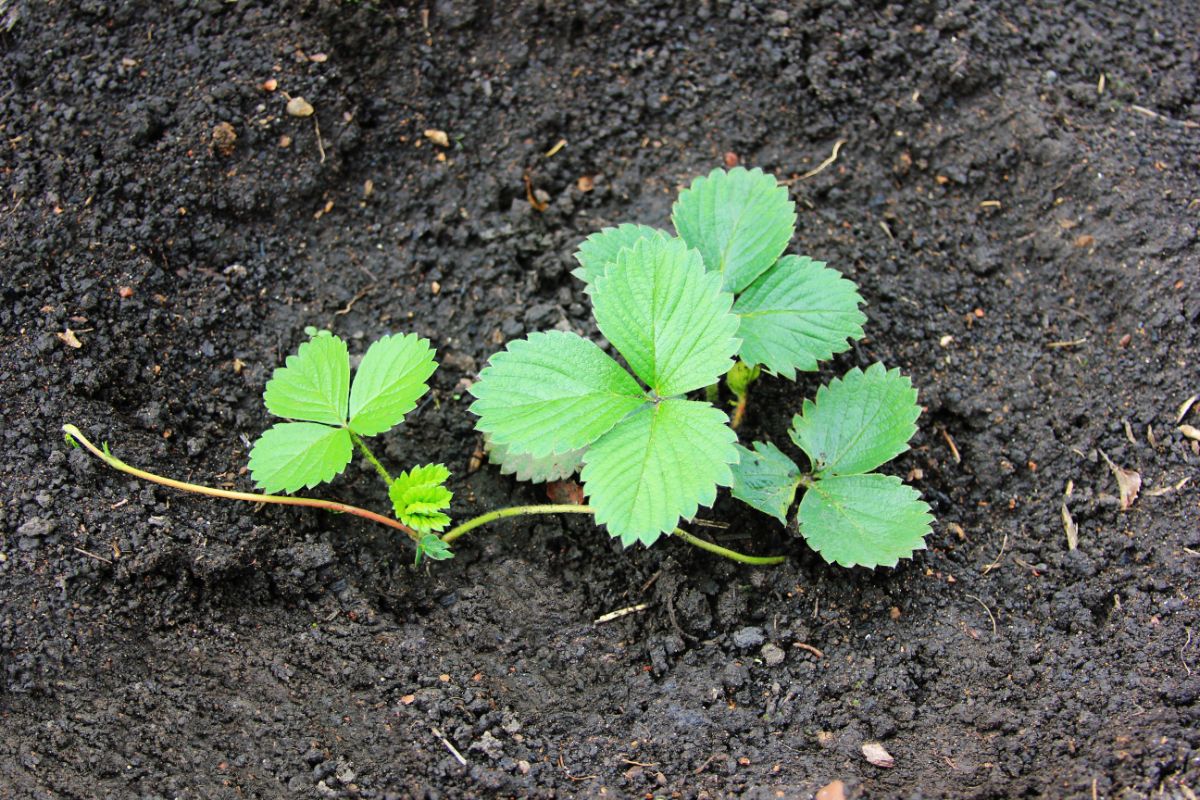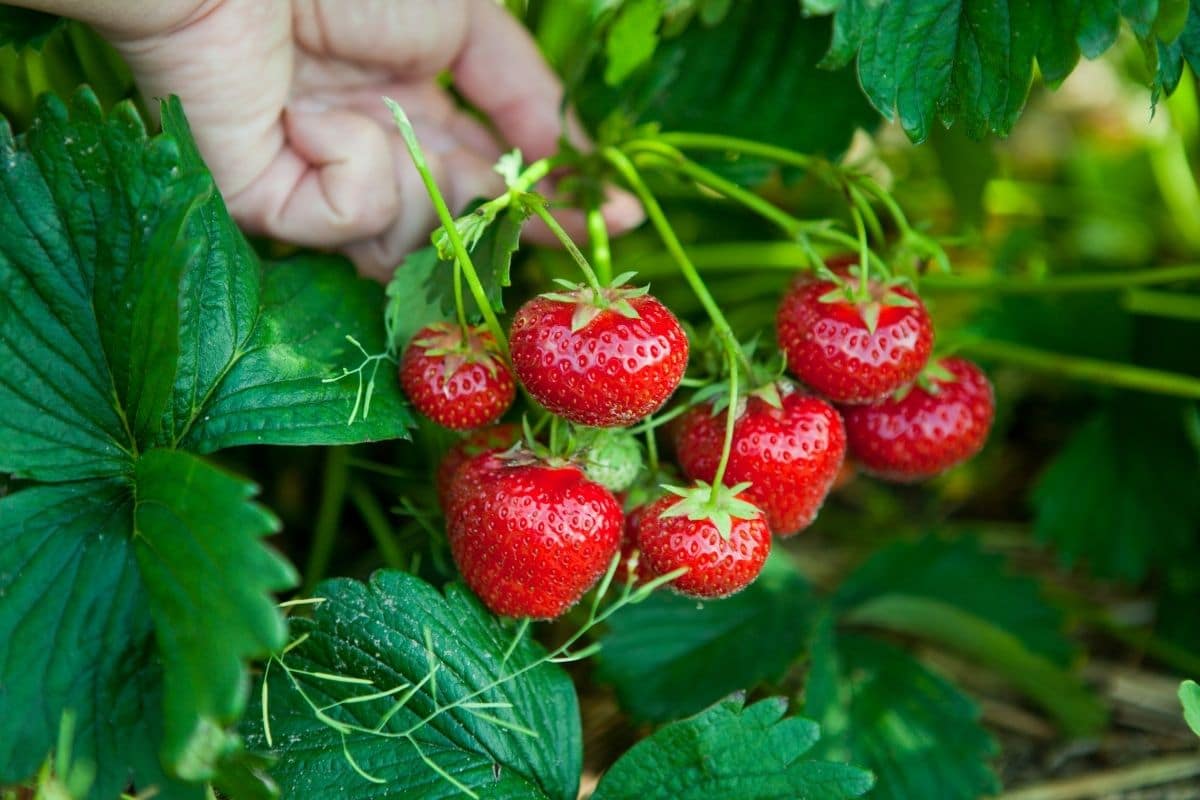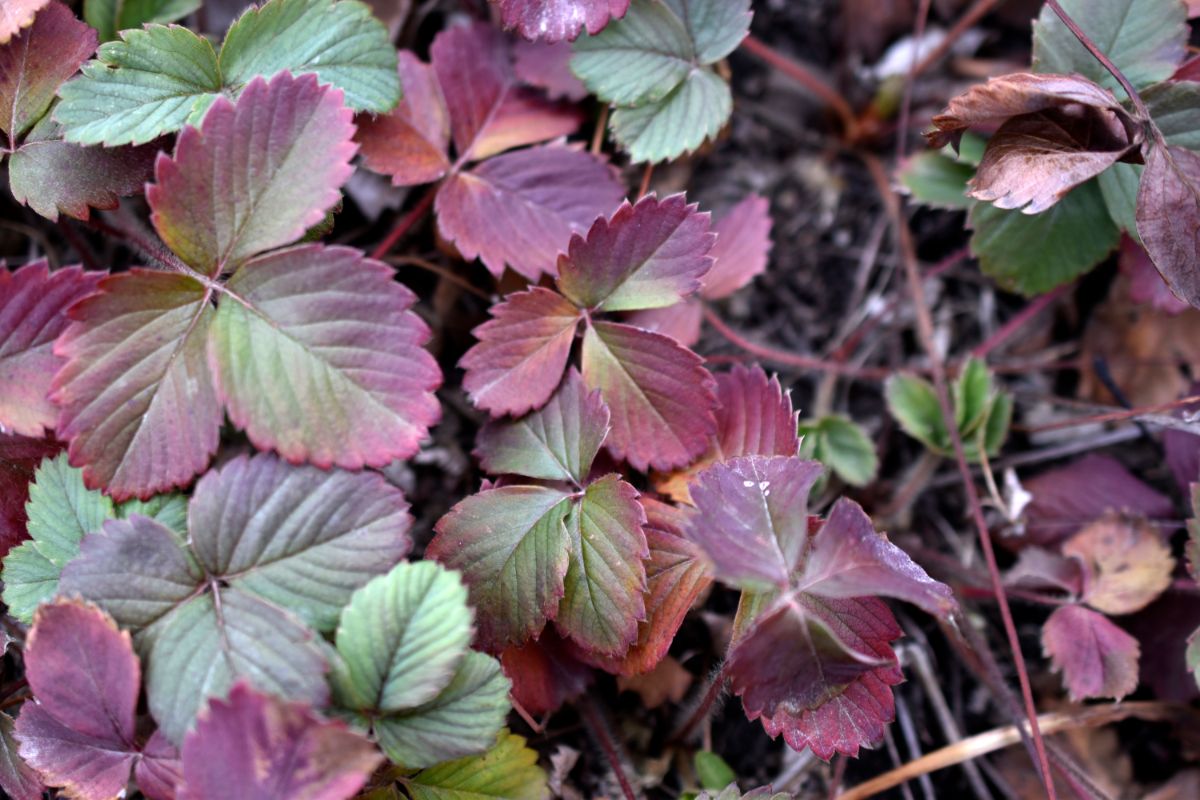There is a tremendous amount of detailed information on our Growing Strawberries page. For anyone just starting out, it is recommended that the starting point be that page. However, it can also be useful to step back and look at the big picture when it comes to growing strawberries.

Since strawberry plants are perennial in nature, they will produce good harvests for multiple years if taken care of properly. This guide is intended to give you a general idea of what it takes to properly care for growing strawberries and dormant strawberries all year long.
This monthly growing strawberries guide and overview will be accurate for most of the United States. The deep south and far north will have somewhat different seasonal benchmarks due to climate. However, the same general steps will be taken, albeit at a modified time.
Jump to:
Monthly Growing Strawberries Guide: Winter

January: Select and order the varieties of strawberry plants you desire to plant. Be sure to order certified, disease-free plants. Feel free to use our directory of Strawberry Plants for Sale Online to find what you need.
February: Fertilize the soil and add lime 2 weeks prior to planting new plants (as soil testing dictates). Plant your strawberry plants if you live in a milder climate. Fertilize established strawberry beds. Apply straw or other mulch to your new strawberry beds when you plant them, either in February or March.
March: Plant your disease-free plants. For maximal production in subsequent years, remove blossoms in year 1. Pay attention to the weather forecast and protect blooms from frost, if needed.
Monthly Growing Strawberries Guide: Spring

April: Remove the previously applied mulch covering from established beds. Cultivate and water. Protect blossoms from any late frosts. Control any strawberry pests. Continue to remove any blossoms on new plants.
May: Cover plants with bird netting to minimize loss. Water strawberry plants if conditions are dry. Continue to remove any blossoms on new plants. Begin harvesting strawberries every other day as they ripen on old plants. Control weeds. Train the strawberry runners wherever you want them to go.
June: Control any strawberry pests. Water strawberry plants if conditions are dry. Harvest ripe strawberries. Continue training the runners. Weed control. Begin renovating old strawberry beds after harvest and fruiting is finished.
Monthly Growing Strawberries Guide: Summer

July: Control any strawberry pests. Water and cultivate. Fertilize, if needed.
August: Control any strawberry pests while specifically checking for mites. Fertilize in the middle of the month. Water strawberry plants if conditions are dry.
September: Control any strawberry pests. Water the strawberry plants. Fertilize in the middle of the month. Thin the plants to about four per square foot. Have the soil tested to guide future fertilization and to check for pests (specifically nematodes).
Monthly Growing Strawberries Guide: Fall

October: Water strawberry plants if conditions are dry. If you will be planting a new strawberry bed, prepare the ground. Target a pH of 5.8 for best results.
November: Either purchase mulch to have on-hand, or locate a supply of mulch than can be obtained once the ground freezes.
December: Liberally apply mulch to strawberry bed once the ground has frozen.
Conclusion
Growing strawberries can be very rewarding. However, it can be easy to forget what needs to be done when. This is especially true after the harvest is over and the thrill of watching fruits and vegetables fades into dormant or dead garden plants and trees. So, use this guide to keep you on track and think about picking strawberries from healthy plants during the next harvest!
Helpful? Be sure to share this monthly growing strawberry guide with others!










Louis Agabani says
Hi
After a good harvest this summer, I have cut the plants back. However, they have all grown back with flowers and now starawberries.
Should I cut back again and mulch or just leave them to overwinter as is.
Russell says
Hello again, I seen the pattern for growing but was wondering how big of a patch should I grow? I would like a big enough patch to put up for the winter, thanks
Tony Nguyen says
Hi Mr. Strawberry
I just bought a small strawberry plant, I did not ask the merchant how old plant is, so how could I know the year of plant to take care.
Thank you
Straw Berry says
Tony Nguyen,
If you just bought it, treat it like a first-year plant. Good luck!
noelle says
My plants are everbearing, new this year. First growth had few blossoms and no berries. Second growth which is now happening had numerous blossoms, berries formed but do not grow farther, become malformed and not edible.
Do I take off these berries and blossoms, mulch and apply fertilizer and hope for another crop? Or, do I wait until fall to groom up the bed and prepare for next year’s growth.
Thanks in anticipation for your advice-much appreciated
Mr. Strawberry says
noelle,
If you have followed the general guidelines on the Growing Strawberries reference page, you may want to check out this information as well on: deformed strawberries, runners but no berries, renovating strawberries. Good luck!
beginner says
I’m finding my strawberry plant is growing a lot of leaves and flowers, but the large leaves are blocking the sun from the fruit, is it ok to prune the long stem leafs(not runners) so my plant is not so bushy. or will this kill the plant?
Thanks for your time,
A beginner
Mr. Strawberry says
beginner,
You shouldn’t trim the leaves unless they are diseased or dead. They are part of the plant’s means of ripening fruit. Direct sunlight can speed the ripening process slightly. but just by a day or two compared the the unexposed underside of the fruit. So, just give them a day or two longer and they should ripen fully for you. Good luck!
Troy says
Hi Mr. Strawberry,
I planted 6 strawberry plants in a 4×4 planter box this April and installed a drip watering system for all 6. The plants are growing great and sending out runners in all directions. My question is if I continue to use the drip irrigation on the mother plants, will it still supply water to the runners? Will there be a point when the runners take root and I will need to change to more of a sprinkler system to provide water to a larger area?
Thanks for your help
Mr. Strawberry says
Troy,
You might need to change your watering system or redirect the drip tape so that the roots of the runners are also getting sufficient water. If you have a significant dry spell and the rooted runners aren’t getting water, they will likely wilt and, eventually, die. Good luck!
Erin says
Hi Mr. Strawberry,
I live in northern IL (in the suburbs just outside of Chicago) and I was wondering if it was too late for me to buy and plant strawberry plants in the ground. I also would like to know what plant variety you recommend for the area, I’m debating between the Allstar, Earliglow or Tristar varieties. If I decide to do some of each, can I plant them all in the same area? I’m a bit limited on space, mainly because we have so many plants in our garden, so could I put then in some type of planter? I’m sorry that was so many questions, I just really would like to get this right without too much confusion.
Mr. Strawberry says
Erin,
It’s not too late! Go ahead and plant. Here are the strawberry varieties for IL. You can plant all of them in the same area as long as there is room enough for each individual plant, and they should do ok in a planter with proper watering and care. Good luck!
subhash says
i have planted in a pot and is it required to change the soil or what type of fertilizer i should use. already i have used a organic fertilizer.
Mr. Strawberry says
subhash,
It would be good to move the plant to fresh soil periodically. See the material on the Transplanting Strawberries page and review the links under the “More” heading here. Good luck!
subhash says
hai i am from india and i have bought a strawberry plant from nursury in the month of november 2011 and in the month of january strawberry comes out and now the same plant is giving runners and full of leaves so this year also it will give fruits or i have to do something for help me out.
Mr. Strawberry says
subhash,
You should have strawberries the first year after planting. If the plant you purchased was already established in a pot, just keep it alive, and it should produce for you. If you purchased a June-bearing variety and it has already fruited, you will need to wait until next year to get a harvest. Learn more about what to do here: Growing Strawberries; and what you might have here: Strawberry Varieties. Good luck!
Taylor says
Mr. Strawberry,
I grew up in the central valley of California, and spent my youth enjoying road side strawberries every spring. I distinctly remember however that, the strawberry patches were plowed under in the fall of every year and planted anew every spring. How are they accomplishing this? Are those folks just settling for a sub standard yield? Are they using a special variety?
I would really love to know how they accomplish this.
Thanks,
Taylor
Brandy says
Hi Mr. Strawberry! This March I planted several bare root strawberry plants in my raised bed gardens. Of about 10 plants, none have any green leaves or visible above ground growth as of yet (April 20) Since it has been more than a month since they were planted I’m wondering if they need more time to develop or if I should consider purchasing more plants… possibly of the potted kind this time?
Thanks for your help!
Brandy
Mr. Strawberry says
Brandy,
If none of them have any green leaves or visible above-ground growth, they are likely dead. I’d recommend purchasing more, after you check with the supplier from whom you purchased. Oftentimes, if your plants are dead on arrival, the nursery will ship you new ones at no additional charge. Good luck!
Beth says
Hi,
I live in NJ and planted a bed of everbearing variety last April and they are coming back strong.
1. Do I need to remove blossoms this year? I have a lot of blossoms.
2. Do I need to fertilize with 10/10 this spring?
Thanks!
Mr. Strawberry says
Beth,
You do not need to remove the blossoms in the second year. If you leave those lot of blossoms alone, you’ll have a lot of strawberries to harvest later! See the Growing Strawberries page (and the links at the bottom) for information on how to care for your strawberries appropriately.
Debby says
If i plant my strawberries in a raised garden will i need to put straw and other mulches before i plant them.
-Debby-
Mr. Strawberry says
Debby,
Planting strawberries in raised beds is actually a great idea as it helps with soil drainage. You don’t have to use straw or other mulches before you plant them, but those materials can help keep the berries clean and the weeds to a minimum following planting. For help with the process, be sure to review the Growing Strawberries reference page.
Cathy Piger (sounds like tiger) says
I will live in NW PA and am moving this winter. I would like to dig up some strawberrie runners and save them to plant in the new location in the spring. how do I go about bear root storage?
Mr. Strawberry says
Cathy,
The easiest way is to dig up the plants you want to keep, dirt and all, and put them into cheap plastic pots. Keep the plastic pots somewhere where it won’t get too warm or too cold (avoid freezing and keep the plants in their dormant state). Putting them in pots will allow you to water them through the winter. If their roots dry out, they die. If you do shake off all the dirt from the roots (not recommended), you can store them in sand, peat moss, wood chips, re-cover with dirt, or just about any moisture-holding medium. Re-plant them in the spring as you normally would. Much more information can be found here: Storing Bare-Root Strawberry Plants.
Brian Roberts says
One strawberry grower did not pinch off the flowers of june bearing plants the first year, and even though the yield was lower, he thought he came out ok over the 3 years he had the strawberries. He grew in red Kentucky clay dirt as I have. Would that work out ok?
Mr. Strawberry says
Brian Roberts,
As it turns out, I lived in Kentucky for four years and know just the red clay you reference. Strawberries are versatile plants and I have seen them grow on the side of a red clay bank and out of a waterlogged pressboard book case. If the grower you mention planted his plants in the fall of the previous year, he was wise not to pinch off the flowers as the plants were established and ready to produce. If he planted in the spring of the same year he harvested, he would almost certainly done better if he would have pinched off the first year’s flowers. But, if the goal is plant and then forget about them until harvest, the method you mention takes the least attention. For more, see this post on Strawberry Flowers.
Sheryl says
Hi! I appreciate your website – great information! I live in the southeast corner of Nebraska. Zone 5. I have been growing strawberries for about 5 or 6 years now. I started with a smaller bed, but later tripled my space – we sure enjoy the strawberries. I have mixed June bearing and ever bearing.
My question is this: I have some plants that have dried up and appear dormant/dead. Will they come back next spring? They have been this way for about 3 weeks now. It has not been any drier than normal this year. I don’t usually water unless it doesn’t rain for a week. We did have an unusually wet spring/early summer and it got really hot for about 2 weeks, but it rained once, so I didn’t water the plants. I always cover with straw in late fall. Should I plan on replanting some of them next spring, or will they come back?
Thanks.
Mr. Strawberry says
Sheryl,
Thanks! The goal for Strawberry Plants .org is to be the one-stop-shop for everything related to learning about strawberries, buying strawberries, growing strawberries, and using strawberries, so I am glad you have benefited from it. There are a few things that may be going on with your strawberry plants. While strawberry plants are considered perennial, each individual plant won’t live forever. generally, a strawberry bed will start losing its vitality after it peaks in the 3rd or 4th year. Sometimes the old plants just die. As your bed is 5-6 years old, the few plants that have died may have just given up the ghost. It is also possible that the fluctuating weather has also put extra stress on them (particularly the heat) and their shallow roots causing the dried up plants to have met an untimely demise. My guess is that the combination of age and weather has caused the plants to die. However, there is a host of pests and diseases that can weaken/infest strawberries. See the Strawberry Plant page for more info on those. Also, I would recommend replanting. You can use the guide on the Transplanting Strawberries page to make sure your plants are healthy and vigorous strawberry producers each year. If more plants die, you may want to have your soil tested by an Extension Agent to rule out disease or pest infestation. I hope that help!
Agnes Ma says
Hi, Mr. Strawberry: I have a question below:
When I root a runner, should I root in the 2nd node (the daughter plant) or the first node. I rooted on the 2nd node since it is called the daughter plant but I am not sure if it is correct.
tks
Mr. Strawberry says
Agnes,
The best resource for square foot gardening is Mel Bartholomew’s All New Square Foot Gardening book. I read and implemented the first edition with great success, and I think the second edition will give you a great source for square foot gardening information. As for pruning your strawberry plants, yes, you need to wait until the plants are established. The easiest way to be sure that the runner plants are established is to wait until the stolon itself (the actual runner between the two plants) begins to brown and shrivel. At that point, you can be absolutely sure that the runner plant has established itself as an independent plant. Then, you can go ahead and sever the runner so that the plants are physically separated.
Agnes Ma says
Hi, Mr. Strawberry:
I have rooted 5 or 6 runners today. I also wanted to prune all my June-bearing strawberry plants. My question is do I have to wait till the runners are established into their new location before I can cut off all leaves to 1″ above the crowns?
I also need to know how do I know the runners are really established into their locations so I can cut off from the mother plant.
tks for your time
Agnes Ma says
Hi, Mr. Strawberry: You should call yourself “Dr. Strawberry”. Tks for all the valuable information. Now I clearly understood what you want. ( as far as runners are concerned.)
I have purchased 4 June Bearing plantings and 8 ever bearing type late this spring to occupy 12 sf. I have also planted 1 sage, 2 marigolds and 1 borage to occupy 4 leftover squares.
I have pinched off all runners as late as yesterday, but I have only pinched off all flowers for both bype for 6 weeks after planting them. Therefore as of today, I have no runners in my plot.
Now I know I have done wrong. I will start letting the runners to grow and root. I will also cutting all flowers on the june bearing type. But what do I do with the ever bearing type? (Bay area has a frost free weather.)
My another queston is I have used 4 sf for companion planting. I felt I wasted too much space. Did I use too much space? (I don’t even know if they are all annuals or not?) How will you re-design the space I have so I can plant more strawberries yet still having some protection against pests? Can I remove all these 4 companion plantings into a large, seperate pot near the strawberry plot? If the answer is yes, then how close this pot needs to be?
Again, both my grandson and I thank you for your help.
Agnes Ma says
Hi, Mr. Strawberry: I am a little bit slow in farming since I never grew anything in my life before. Strawberry plants are my very first one to try. My grandson (I am 66 years old now) begged me for it since he loves strawberry so much I started to think his last life must be a strawberry.
Let me see if I understood you correctly:
On year one, I shall plant with just 1 plant per sf. So when planting, I shall plant at one corner of the sf and leave all other corner & center space empty for future 4 runners to grow in. I shall cut off all runners in the first year doesn’t matter what type I planted. So at the end of first year I still only have 1 plant per sf.
In year 2, I shall allow 4 runners per sf to root in those reserved space. So at the end of 2nd year, I shall have 5 plants per sf. Do I read you correctly?
I appreciate your patience with me and my grandson thanks you also. He kept complaining too little strawberries this year.
Agnes
Mr. Strawberry says
Agnes,
If you have a 4×4 foot garden plot, plant one strawberry plant in the center of each square foot during the very early spring. Pinch or cut all the strawberry flowers off of the plants in year one, but allow the strawberry runners to grow and root within the 4×4 feet of garden. At the end of the growing season, thin the runner plants IF they are too crowded. 4 to 6 plants per square foot (on average – most things don’t have to be exact in the world of gardening) is a good target. Over-winter the strawberry plants (see the Growing Strawberries page for help). The following spring, enjoy lots of sweet strawberries. You should reap a harvest from both the initial plants and the cloned plants they sent forth via runner.
Agnes Ma says
Hi, Mr. Strawberry:
tks for your reply. I forgot to mention that I planted the strawberry plants on my 2 feet tall raised bed. The size is 4’x 4′.
As I said in the earlier email that I planted 1 plant per square foot. The 4 x 4 bed looks full now even with 1 planted per sf. You really think I could plant 4 per sf? Will it be overcrowded?
I intend to start another 4′ x 4′ raised bed next January ( I live in bay area, California). Therefore I need your advice so I may plant the correct quantity per sf.
Tks
Mr. Strawberry says
Agnes,
Generally, when you start a new bed, 1 plant per planned square foot is all you need to purchase. In year two you will begin to reap significant harvest, and the runners from June-bearing plants will fill in the rest of the square footage by the second year. Strawberry plants don’t have enormous root systems like some plants do, and one square foot of appropriate soil can usually provide sustenance for four healthy strawberry plants without too much difficulty. In fact, my square foot garden easily supported 6 plants per square foot. Those plants provided me with big, healthy berries for multiple years. Thinking of it this way might help: plant 1 strawberry plant per square foot but leave 4 strawberry plants per square foot for subsequent years. I hope that helps!
Agnes Ma says
Hi:
I only started to learn growing strawberry beginning this spring. I was lucky to find your website since you have very good information on this subject.
In your September activity list, you mentioned to thin the plants to 4 per square foot. But I have read from many source to set the plants 12″ apart in rows spread 18″ apart.
My question is: can I grow 4 plants in one square foot. This spring, I planted 1 plant on each square foot. If I could plant 4 plants per square foot, it will be great. I will change the planting spacing when it becomes possible next time. Pls let me know the best spacing for strawberries.
Tks,
Agnes
Mr. Strawberry says
Agnes,
Thanks for stopping by Strawberry Plants .org! When you purchase plants (or transplant them) and initially set them out, you definitely want to space them far enough apart in rows or another planting system (see the Growing Strawberries page for more on this). The goal, however, when using the matted row system is to allow the runner plants to fill in the rows to maximize the use of the growing space. But, the rows can become TOO “matted” and need to be tended, cut back, or renovated. For me, I hate having to destroy the plants, so I usually give away my extras. Leaving four strawberry plants per square foot is the maximum you should leave within a matted row. Any more and you will likely see a drop-off year-to-year in your yield as the strawberry plants become too thick and choke each other out. I hope that helps!